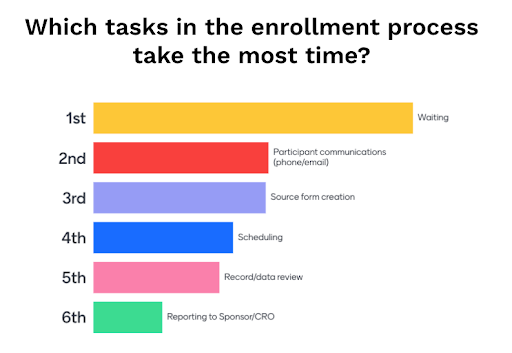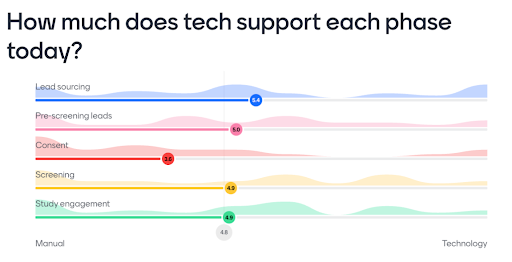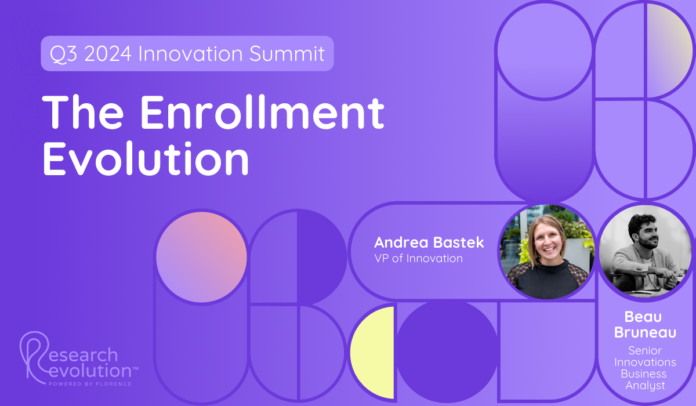The Q3 Innovation Summit topic, “Enrollment Evolution,” came from audience input at the Q2 summit that participant enrollment and engagement are still some of the biggest challenges in the industry. When the Innovations Team hears about industry challenges, we don’t just start building a new tool. We dive into the problem, analyze the current processes, and try to identify areas where the process can be improved. We follow this engineering design process because we’re nerdy engineers, but also because we know that just throwing technology at every problem isn’t the right answer. We have to understand where the process is broken in order to identify the parts of the process where tech might help. During the summit we polled the audience to help answer this question:

Waiting! Waiting takes the most time in the enrollment process. Waiting for someone to call you back or answer that email or fill out that survey. Of course staff can use that time for other tasks but all that waiting time means that the process takes longer than necessary. Interesting, but not all that surprising when you think about it.
We also asked the audience where they are using tech today in their processes:

On average, the enrollment process is still very manual, but as with all process evolution, there were some early adopters responding over on the high-tech end of the scale. And it’s not surprising that a fair number of attendees at an Innovation Summit would be early adopters.
In breakout rooms, the audience participated in discussions about “Mastering Enrollment Strategies with Process” and “How Innovative Technology Can Transform Patient Enrollment.” Here’s a summary from each room:
Mastering Enrollment Strategies with Process
This room was packed and the discussion was vibrant. People were eager to share what has worked for them and learn from others in the room. Three ideas emerged as tactics that have been particularly helpful:
- Creating pre-screening scripts for coordinators both reduces burden on the coordinator and increases conversion of leads to participants.
- AI tip: use an LLM like chatGPT to generate 30-60 second phone scripts based on your protocol. You can copy and paste this prompt in chatGPT.
- Distribute brochures to community physicians in your area with your study portfolio on a monthly basis to increase referrals to your trials.
- AI tip: use an LLM like chatGPT to generate the content for your brochure and paste it into your template. You can copy and paste this prompt in chatGPT.
- Conduct outreach through your EHR and stage participants in a smaller database for each study to track your performance and leverage resources you already have.
How Innovative Technology Can Transform Patient Enrollment
This room attracted those innovators and early adopters who are already using some tech in their enrollment process. They were passionate about efficiency and eager to talk about how to make tech work better:
- There is still a technology optimization gap: Folks were often creatively patching together multiple technologies, such as spreadsheets, kanban boards, data visualization tools, texting software, calendering software as well as EHR and CTMS to reduce manual effort and increase efficiency. Remember, these are innovators and early adopters. None of the tools are fully integrated or optimized for the screening and enrollment process YET, but the future possibilities are exciting!
- The potential for AI is huge: There is significant potential in leveraging AI and large language models (LLMs) to identify and pre-screen patients within Electronic Medical Records (EMRs) or other databases. However, current tools are hard for sites to implement and not all of them are fully equipped to handle complex inclusion/exclusion criteria lists or the large volumes of unstructured data that has to be reviewed during screening, BUT the tech is changing quickly and again, the future is exciting.
- Recruitment Vendor Limitations: Recruitment vendors generally still are not meeting site expectations, delivering poorly qualified patients or cold leads. Of course this is highly dependent on therapy area and study complexity, but sites are eager for improvement in this area.
As always, we are grateful for the incredible audience participation in our Summit. We’ll see you next LIVE at Research Revolution!
Andrea & Beau



